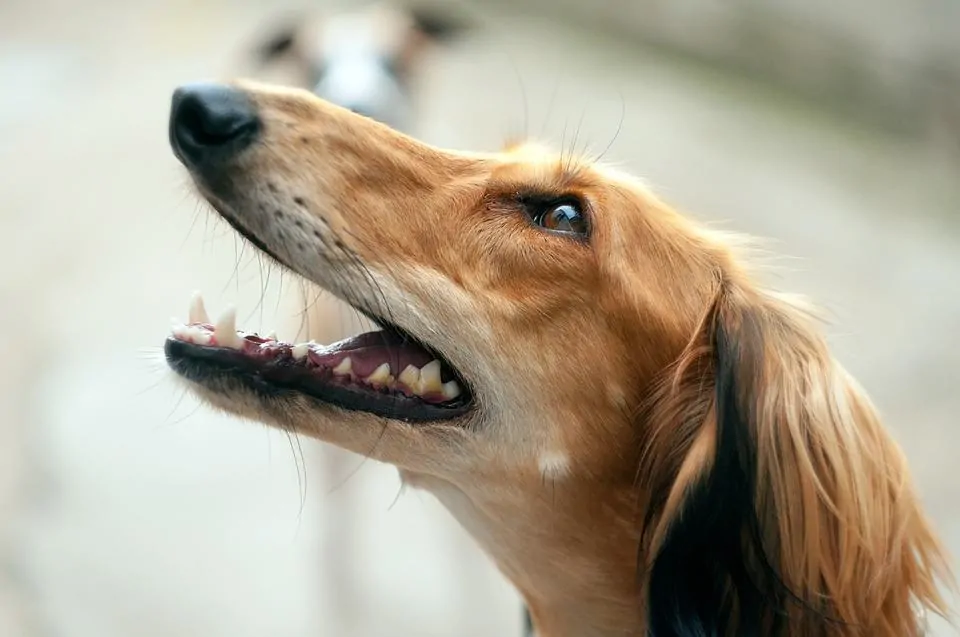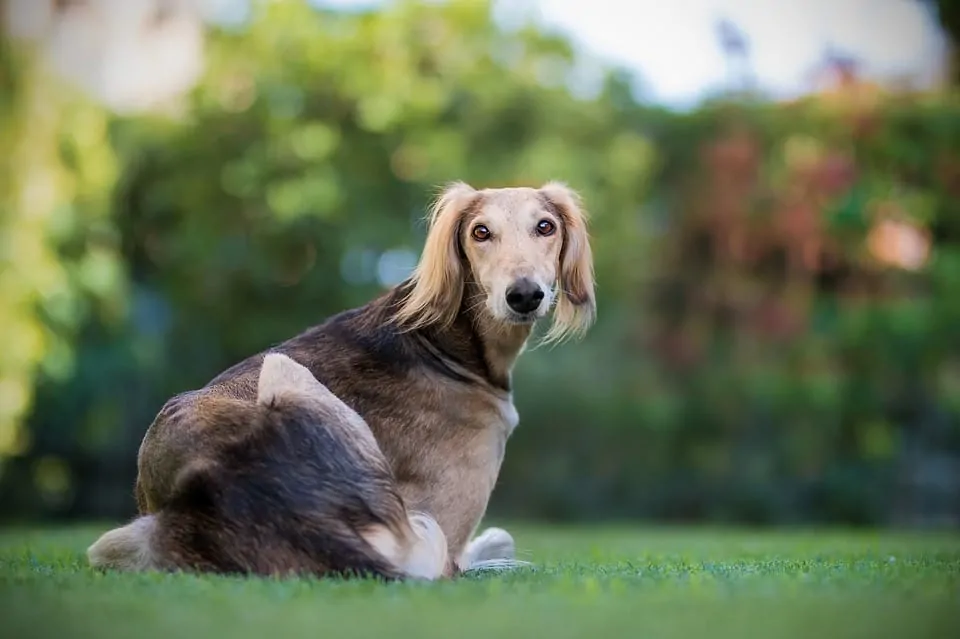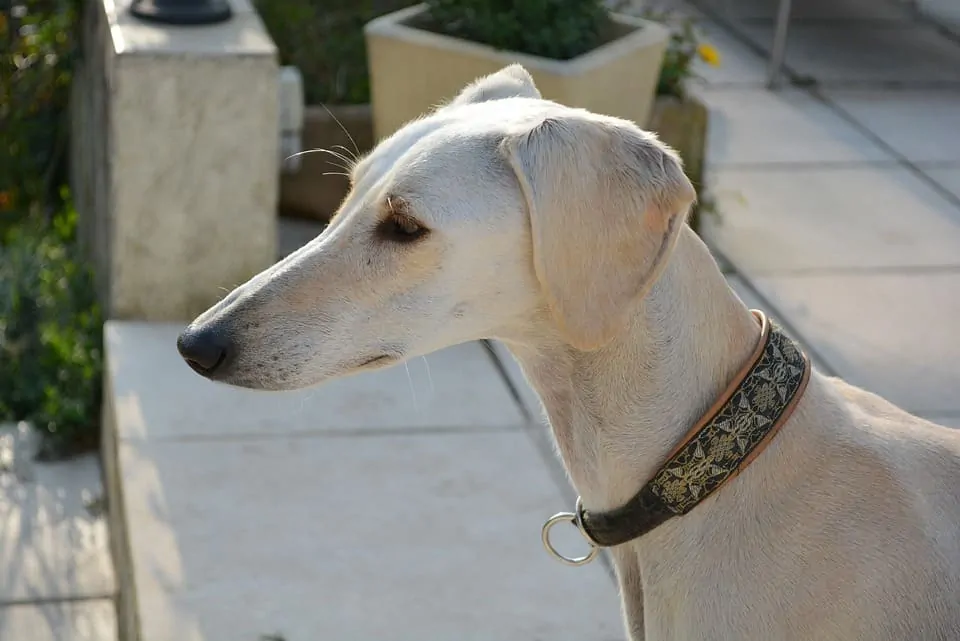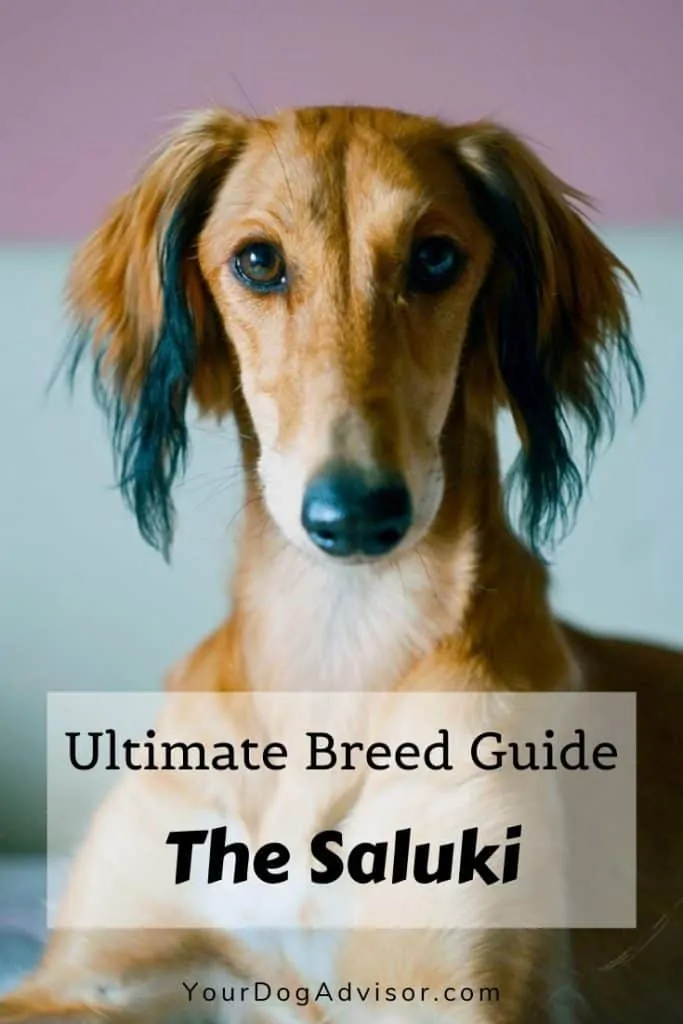Graceful, elegant, and independent, the Saluki is unlike most breeds. For many humans, these stubborn, cat-like dogs aren’t a great fit. But for the right owner, this dog has an intoxicating quality that may ruin you of all other breeds.
Keep reading to find out what it is about the Saluki that makes them so irresistible to the right people and to find out if you might fit into that category.
Contents
General Characteristics of the Saluki
- Other names: Persian Hound, Gazelle Hound
- Height: 23 to 28 inches
- Weight: 40 to 65 pounds
- Lifespan: 10 to 17 years
- Origin: The Fertile Cresent (Middle East & Egypt)
- Colors: White, cream, golden, grizzle, fawn, red, black and tan, and tri
- Activity level: Moderate
- Grooming needs: Low
- Best suited for: Responsible owners not looking for the typical doggy dog
Somewhere between the Afghan and the Greyhound, this breed is the epitome of elegance and grace. But don’t let their look fool you, these hounds are powerhouses of speed that can tolerate the harshest environments.
The History of the Saluki
The Saluki is one of the oldest dog breeds still around today.
These sighthounds can trace their ancestry back at least 5,000 years and possibly as far back as 7,000 years to an area known as the Fertile Cresent.
It was here, in the modern-day countries of Egypt, Iraq, Syria, Lebanon, Palestine, Isreal, and Jordan, that humans first perfected the art of agriculture. Alongside them were the first domesticated canines.
Over time, some of these dogs were selectively bred to aid hunters in bringing down game in the large, open desert areas of the region. To do this, hunters chose dogs with long legs, slender bodies and heads, and keen eyesight that could not only track and chase prey but were large enough to bring it to the ground.
This perfected sighthound took on the look of the modern-day Sals. It was a dog with a light build, thickly padded feet to allow it to sprint over rough terrain, and the speed to keep pace with the fastest prey.
These dogs quickly became popular with royals of the region, especially in Egypt where they were often embalmed with nobility and celebrated in paintings, carvings, and sculptures.

In the Middle East, dogs were considered unclean by most Muslim sects, but the Saluki was so valued that they were allowed in the home.
Whether kept by nobility or by the common man, these dogs were used to hunt a variety of game from hare to jackals, but they were most well known for their ability to chase down the gazelle, an extremely fast antelope native to the region.
Despite their ancient lineage, these dogs remained largely unknown outside the region until the late 1800s. They did not become popular breeding dogs until soldiers returned to Europe with larger numbers of them after serving in the Middle Eastern theatre during World War I, however.
But the popularity of the breed in Europe and America fell after the start of the Second World War. In fact, rations were so limited during that time that many kennels chose to euthanize their dogs rather than letting them starve to death.
After the war, the breed made a recovery through the import of more dogs from the Middle East.
Today, there are many different Saluki lines, including some that have been bred in the West for over a century and some that hold true to their native roots in the Middle East.
While they have always remained one of the less popular dog breeds by numbers, they are adored by those who have opened their lives to them.
Watch the video above to see a pack of Salukis hunting hare the same way their ancestors have for millenia.
The Temperament of the Saluki
Like most sighthounds, the Saluki can be aloof, independent, and cat-like in demeanor, especially around those they are unfamiliar with. They are not prone to roughhousing, following their owners around the house or obeying your every command.
These hounds are observant and sensitive, but are easily bored with training and would much rather entertain themselves than learn anything you want to teach them.
As puppies and adolescents, they have a good deal of energy and need a lot of time to run around and blow off steam. They are known to become destructive if bored or understimulated. Young puppies need to be socialized in a variety of situations and with many other people and dogs or they are likely to grow up to be skittish adults.
Once they hit adulthood, these dogs tend to calm down, especially when spending time indoors. They enjoy lounging about but require comfort. These are not dogs that will happily lie on the floor when there are comfy couches and beds to be slept on.
Luckily, they are also very clean dogs and don’t have that typical doggy odor. They rarely require bathing and they shed very little.

They make surprisingly good apartment dogs assuming they receive a long daily walk and are given frequent opportunities to run off-leash. Unfortunately, due to their selective hearing and propensity to chase small animals, they should only ever be allowed off-leash in enclosed spaces.
Sals are happiest in homes with large fenced backyards. They are agile jumpers and can clear a four-foot fence with ease. And once they are free, it can be a challenge to get them back, so a secure yard is a must.
Overall, the Saluki makes the perfect companion for any owner that respects a dog that knows what it wants and is fine to only give attention when the dog asks for it. They are loyal and loving in their own unique way and are always a sight to behold.
Health Issues Common to the Saluki Breed
The Sal is generally a healthy breed with only a few notable genetic issues. Here are some of the more common problems owners should be aware of before looking at purchasing one of these Persian hounds.
- Heart Valve Disease
- Arrhythmia
- Enlarged Heart
- Thyroid Issues
- Cancer
- Bloat
- Skin Issues
Ever watchful, this breed is known for finding their way into trouble by chasing squirrels, cats, birds, and other small animals across streets. When on the hunt, these dogs can run for miles, so don’t expect to get a wondering Sal back quickly or easily.
Salukis can have fairly long lifespans for dogs their size and are generally very healthy, especially when purchased through a reputable breeder. Unfortunately, the most common cause of injury or death in these dogs has nothing to do with disease.
This landrace dog has been selectively bred to chase down prey for thousands of years. Their instinct to run after anything fuzzy and fast is so ingrained that no amount of training is likely to be enough to successfully recall a Saluki once it has taken off after a squirrel, cat, or other animal.
For this reason, one of the most common causes of injury and death in this breed is being hit by a car. And given their slender bone structure, narrow skull, and overall build, these accidents rarely have a positive outcome.
This is why it is especially important that you take time to consider if you will be able to keep this kind of dog safe and provide the exercise they need before you get one.
Sals need to be kept on-leash at all times when not in an enclosed area. But they also need to run free in order to fulfill the ingrained urge to chase and to exercise them properly. Finding an enclosed athletic field, dog park, or even a neighbor’s yard is a great way to allow your pup to run without risking the getting loose or taking off on you.
Do Salukis Do Well With Children and Other Pets?
Much like with cats, how well a Saluki does with children depends largely on their individual personality.
As a whole, the breed is not known for being overly tolerant of pain or rough play. They also tend to shy away from loud noise and activity. While this gentle dog is unlikely to bite, and will always prefer to walk away from an uncomfortable situation, if they are not given the chance, things can easily end in disaster.

That isn’t to say these dogs can’t coexist with children. When socialized with babies and children from a young age, they can end up being very amicable siblings as adults. Still, it is always important to monitor child-dog interactions and make sure the child is treating the dog with kindness and the dog is not getting uncomfortable.
As for other dogs, much of the same logic applies. Well-socialized Sals tend to do very well with other dogs and are rarely territorial or aggressive. Young pups even tend to be very playful and rambunctious. As they get older, they tend to prefer to spend their days hanging out, however, and may not be excited about sharing the house with a rambunctious dog.
When it comes to other furry family members such as cats, bunnies, and birds, the answer is much more straightforward.
These hounds are hunting dogs through and through. While they may not immediately pounce on the hamster’s cage, if they see the little creature move, they will want to chase it. This is something that will become immediately clear once you watch your pup interacting with squirrels and birds in the yard.
While there are sure to be a few exceptions, generally this breed does not do well with smaller animals and is best suited for a home without cats or rodents.
What to Consider Before Bringing Home a Saluki
Think you are the type of person who would immediately fall in love with this elegant canine? Here are a few more things to consider before you bring a Saluki home.

Activity Level
Puppies and adolescent Sals tend to have a good amount of energy and will require daily walks and plenty of trips to the running court or ample playtime in the backyard. As they get older, this excess energy tends to dissipate, but the breed still requires frequent exercise to stay fit and happy.
Coursing, agility, and other dog sports can be a great outlet for this energy and a good way to stimulate your dog’s mind as well as their bodies.
Trainability
Sighthounds, in general, are not well known for their intelligence. And this breed is no exception. While that certainly does not mean Salukis aren’t smart, it does mean they are not the kind of dog that always wants to please you. In general, they are much more interested in pleasing themselves.
>>>Want to get your pup started off on the right paw? Here are ten important things to do in the first ten days.
Starting your pup in early training classes is a good way to construct a healthy training foundation and teach them some basic skills early on. But, overall, patience and consistency are the keys to living harmoniously with this breed.
The Sal’s coat is silky and thin and requires very little maintenance. It can come in a variety of colors and patterns.
Grooming
Salukis come in two coat types. Smooth-coated dogs have very fine, short hair over their body with slightly longer hair on the ears. Rough coated dogs have similar coats on the body but with feathering on the legs and longer hair on the ears. Both types only require occasional brushing and will rarely need to be bathed.
These dogs don’t shed often and lack the typically odor most canines posses.
Nutrition
Like most dogs, this breed will do well on any quality diet that is high in protein. Choosing a food that is higher in quality animal fats may help nurture the skin and coat and avoid some of the dermatological issues these dogs are prone to. Some Sals eat like cats while others eat like hounds. If your pup has a heftier appetite, it is important to pay special attention to their weight and make sure they are getting enough exercise, though it is unusual for these dogs to become obese.
Cost
This rare breed comes with a hefty price tag. The average purebred puppy costs about $2,500.
They are fairly easy keepers, however, and shouldn’t cost more to own than your typical dog of similar size.
10 Fun Facts About the Saluki
Now that you know what it takes to own a Saluki, here are some fun facts about the breed.
- The breed comes in two coat types, but the rough-coated variety tends to only appear in the West and is not typical of the breed’s ancestry.
- Ancient hunters are said to have carried these dogs with them while riding on camelback and throwing them to the ground after spotting the game to give them a headstart.
The Sal coat comes in two types, with the rough, feathered coat most recognizable and the smooth coat more typical of dogs found in their homeland.
- Like all landrace breeds, these dogs hunt by eyesight not by scent or sound.
- This breed can maintain high speeds for longer than the Greyhound.
- Evolving alongside the first humans to perfect agriculture actually shaped these dogs’ genes. One gene that helps dogs digest starch was found to be present with two copies in wolves, with three to four copies in Huskies, and with twenty-nine copies in Salukis.
- While the number of these dogs is low in the West, they are plentiful in the Middle East and many rescues work to bring stray Saluki-type dogs to Europe and America for adoption.
- This breed is highly adaptable and can stand even the harshest of conditions.
- This breed and the African Sloughi were considered the same for some time, but recent DNA analysis has revealed that they are two distinct breeds.
- Arab tribesmen called the breed “el hor,” which means “the noble.”
- Like all sighthounds, these dogs aren’t easily recognizable as puppies, as their features tend to be stubby and round until they reach a few months of age.
Before You Go
Not sure a Saluki is right for you? Here are a few more breeds to consider.

Sara Seitz has spent most of her life in the pet industry and has a bachelors in animal behavior from Colorado State University. Sara started working with dogs and cats as a high schooler at a rural boarding kennel. There she learned a lot about the bad and the ugly of the pet service industry. But not even the toughest day at that job would dissuade Sara from following her dream of working with animals.
In college, Sara got a job at a dog daycare and boarding facility in Fort Collins, Colorado. Her new career provided even more opportunities for learning about dog behavior than her classes did. As general manager of the daycare, Sara helped the company launch a new in-home pet sitting branch and trained to become a certified dog trainer. Between shifts taking care of peoples pets in-home and supervising dogs during playtime at the daycare, Sara organized and taught obedience classes.
Sara has always been passionate about bettering the lives of our canine companions. She soon found that advocating for and educating owners in the power of positive reinforcement training was one of the best ways to help dogs and their owners live happier lives.




